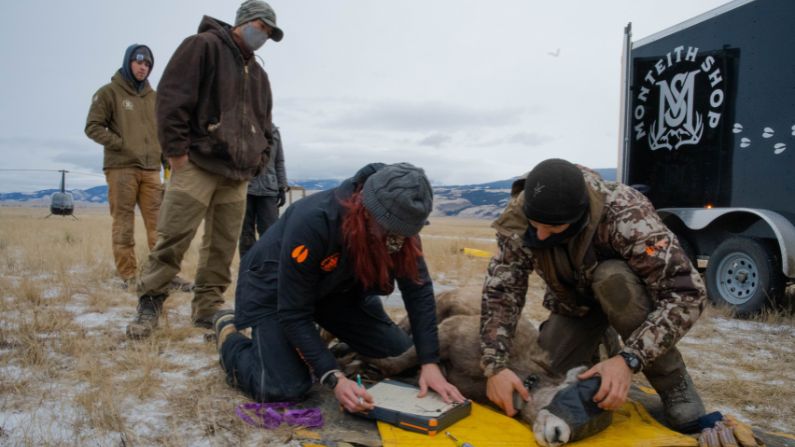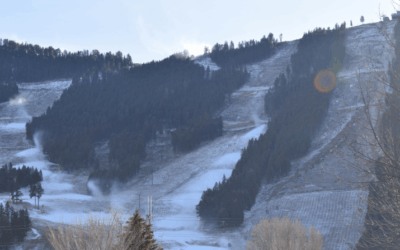KHOL and Stio recently launched a new limited-run podcast series called “Facets: Voices of the Mountain Life.” In five episodes, Facets explores the passions, tensions and healing that people find while living in a mountain town. The second episode, “Preserving a Teton Icon,” debuted on Friday, April 15, and the rest of the episodes will be published every other Friday through the end of May.
KHOL’s Will Walkey reported and produced the second episode on the proposed winter closures in Grand Teton National Park aimed at protecting bighorn sheep. Listen above to hear Walkey discuss his reporting and making of the episode with KHOL Music and Community Affairs Director Jack Catlin.
The following interview transcript has been edited for clarity and brevity.
JACK CATLIN: Will, how did you first get involved with this story?
WILL WALKEY: So, like so many stories these days in journalism, it actually started through social media and actually Instagram. I want to give a quick shout-out to my friend Henry Dodge, who actually pointed me to this story first. And it was a post from a backcountry skier with a big photo of the Tetons with a big “Closed” sign in front of it, basically talking about this proposal that’s been happening through Grand Teton National Park and a few other public lands organizations. Basically to close 21,000 acres. This is a huge swath of land in the Teton Range, in the winter, in order to protect this small herd of bighorn sheep.
For a lot of reasons, people care about this in terms of wildlife conservation. The skiing community also cares about this because they like to be able to go where they want in the Tetons. It’s one of the best parts about living in Jackson Hole. And so, I dug a little deeper and learned about the biology behind this [and] some of the politics behind this decision. And overall, why this has been an effort that’s been going on for decades and why people want to try and protect the sheep, and also why these closures might help.
CATLIN: So, who did you talk to on either side of the issue?
WALKEY: In the episode that’s out today, [of] Facets, there’s going to be three main characters that you hear from. One is Michael Whitfield, who is sort of the original modern-day student of the sheep. He started tracking sheep back when there was really no GPS. At the time, they were actually thought to be extinct in the Tetons because no one could really get up that high. This was in the late ’70s and early ’80s, and he would go out there, basically total mountain man, by himself for 10 days at a time, [with] 80-pound instruments on his back, tracking the sheep, even tracking as far back as before white settlement–back when Native Americans were the only folks in the Tetons. There’s evidence of them interacting with sheep. So, he’s one of the main characters.
The next is sort of the modern biology student. Her name’s Aly Courtemanch and she currently works for the Wyoming Game and Fish Department. In 2014, she did a master’s thesis where she actually tracked backcountry skiers. Tracking their movements around the Tetons. They were voluntarily putting GPS trackers on themselves and then [the project was also] collaring sheep, looking for correlations and looking for ways that skiers and sheep were impacted. What she found is that bighorn sheep, when humans are sort of there, even if they’re not hunting them, threatening them. You know, sheep are super skittish and perceive humans as a threat. So, they’re burning energy in an already really remote landscape. And so she found that, basically, humans are negatively impacting sheep when they’re in the backcountry.
And then the final main character is Mark Smiley. He’s a backcountry guide, and he’s been skeptical about the proposed closures for honestly, a really good reason, which is that he loves public lands. And at the end of the day, he is looking for reasons to not have to do the closures. But he’s also really someone that cares a lot about this environment in Jackson Hole. And so, I think that he was a really interesting case study in terms of how the ski community is sort of reacting to these proposed closures, which I think anyone that has been out there in the backcountry knows why this is something that would impact them and why this is something that they want to learn more about.
This was sort of a several months-long project. It was a lot of talking with people behind the scenes. At the end of the day, a podcast is about characters, and I wanted to highlight these three main people. But there are lots of side people that I talked to along the way that didn’t quite make it into the final episode.
CATLIN: I’m just curious, what area exactly is being proposed [for] closure and how long will that closure be intact?
WALKEY: That’s a really good question. So, it’s 21,000 acres. I will say, the iconic lines that most people think of when they think of backcountry use in the Tetons, for example, 25 Short, a lot of those are going to stay intact. The main closure areas, and there are maps available–I haven’t really been up to there. I’m not as prolific of a backcountry skier, yet. But it’s extreme territory for sure. You know, these backcountry proposals have been in place for a number of years, and so a lot of the bighorn sheep biology community has been talking since before I started reporting this to folks in the backcountry community about what areas should be closed, what areas should not be closed and can we come to a compromise where we’re still preserving a lot of space for the sheep while also keeping some of the main lines open?
So, this number is really disputed, but a lot of people say that 95% of what the skiers during these conversations perceived as high-value terrain, so what they care about the most, has been preserved under these closures. In terms of how long, that’s a really good question. And that’s definitely a sticking point because, you know, there’s only about 100 to 125 sheep.* They are in danger of extinction, according to the biologists I talked to. And so, if you do a closure, the goal is for that population to start recovering. They have the space to breathe. Do their different sheep things in the winter and survive more often and start to recover. But for that population to even double probably takes five to 10 years. So, is it in perpetuity? No. But is there an end date on it? Definitely not. And to be honest, I think the biology community would admit it’s probably potentially not even in our lifetimes.
CATLIN: Will, is there anything else you’d like to touch on?
WALKEY: For me personally, this is the first podcast episode I’ve ever gotten to do. It’s 29 minutes. You know, this was a long, drawn-out process. I’m really hoping to hear feedback not only from folks that care about this in the ski community [and] biology community but also just folks in Jackson who like this unique place. This is a story in many ways about our public lands. Who are our public lands for? How do we interact with them, and what does it mean to preserve public lands for future generations? Also, where do wildlife get into play? And in the case of the bighorn sheep, it’s getting to the point where maybe if humans keep doing what we keep doing, this population of bighorn sheep might go extinct. And there are so many other reasons for that. You know, it’s not just the backcountry skiers. It’s development in Jackson Hole. It’s air noise pollution and all these other things. But at the end of the day, I think it’s a really interesting case study.
And you know, one line that was in the preview for the episode, and that I keep coming back to is, ‘If we can’t solve an issue like this in Jackson Hole, where else can we do it?’ Because we live in one of the most unique ecosystems in the country, on the doorstep of the Greater Yellowstone Ecosystem. There’s bears, there’s bison. You know, there’s really no more unique place in the Lower 48. And elsewhere in the country, we’ve just seen populations of animals decline so much from human development, and any biologists that you talk to are very pessimistic that we can try and turn this around [to a place] where animals are going to start to recover. Maybe in Jackson Hole, with this tiny population of sheep, we can actually do it if there’s some collaboration. I’m optimistic that we can get this done, and it was exciting to report.
CATLIN: You can listen to Facets on Spotify, Apple or wherever you listen to podcasts.
*EDITOR’S NOTE: A recent study from Grand Teton National Park found that there may be more bighorn sheep in the Tetons than was previously thought. Data from droppings and other DNA samples in the area revises current estimates to around 178 sheep, a major increase and a “breath of good news” according to local biologists. The park is still moving forward with its closure proposals, and a survey asking ski community members how they feel about the potential measures is available here.






